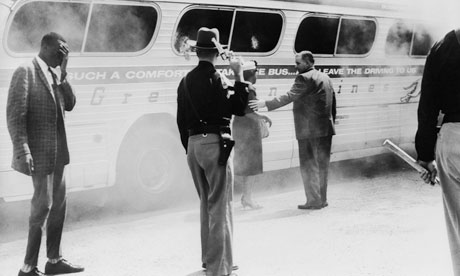
I have a friend who cannot abide Harper Lee's To Kill a Mockingbird. He likens its place in the American psyche with the – perhaps erstwhile – popularity of President Obama: it's nothing but a fig leaf, he argues, a fairytale that fails to engage with the corrosive reality of racial inequality in the United States. Ouch.
This withering assessment of To Kill a Mockingbird is neither unusual nor new. Perceived shortcomings in Lee's classic novel of life in the American south are commonly focused on the development of her main characters. It's been argued that the principled depiction of Atticus Finch – the lawyer whose decision to defend a black man accused of raping a white woman forms the heart of the book – comes at the expense of one-dimensional, even offensive representations of black characters. According to the American Library Institute, To Kill a Mockingbird was the 21st most "challenged" book of the last decade. Objections included the suggestion that the book "represents institutionalised racism in the guise of good literature" and that the use of racial epithets in the text constitutes an act of racial prejudice in itself.
One would not want to suggest any work of literature – especially one as popular as To Kill a Mockingbird – should be exempt from critical re-evaluation. But it might be helpful to step back and consider the book from within its social and literary context before subjecting it to an intellectual kicking.
It must be remembered that To Kill a Mockingbird was both a critical and commercial success on publication, with sales of 500,000 copies in the first six months of publication alone and broadly positive reviews. But its subject matter was anything but commercial fodder for the time. Brown V Board of Education, the landmark case that formally outlawed segregation in American schools had been decided just six years earlier; racial discrimination still remained a fact of life for many. The court case at the centre of To Kill a Mockingbird shows up the absurdities – and the horror – of segregation and racial bias; with this in mind, I'm inclined to consider To Kill a Mockingbird as a contribution to the cause of the civil rights movement, rather than as reinforcement of the racial cues of the period.
Then there's the question of perspective. To Kill a Mockingbird is seen through the eyes – if not quite told in the voice – of six-year-old Scout. What the book presents is an unmediated portrait of a specific time and place, as experienced with the naivety of a small child. In this sense, perceptions of slightness in the development of the principal black characters – Calpurnia, the family cook for instance, or Tom Robinson, wrongly accused of rape – are a product of Scout's engagement with life in Maycomb County, rather than a blinkered paternalism on the part of Lee. To Kill a Mockingbird is concerned with racial prejudice, but with other social issues besides; class, gender, politics, poverty. Scout's engagement with all these facts cumulatively create a rich and detailed tapestry; the perceived shortcomings in the characterisations – and one might add to this, for example, Scout's bemusement with the poor white Ewell family, who accuse Robinson of rape - merely emphasise Scout's comprehension of a particular time and place.
Cumulatively, what emerges from To Kill a Mockingbird is a thoughtful disquisition that encompasses – and goes beyond – the question of racial bias at its worst. Justice, we learn from Scout, is often complicated, but must always be founded upon the notion of equality and fairness for all. This is an issue that still matters today; for this reason alone I think we all ought to celebrate this wonderful book, rather than project upon it grievances that it never proposed to resolve.

